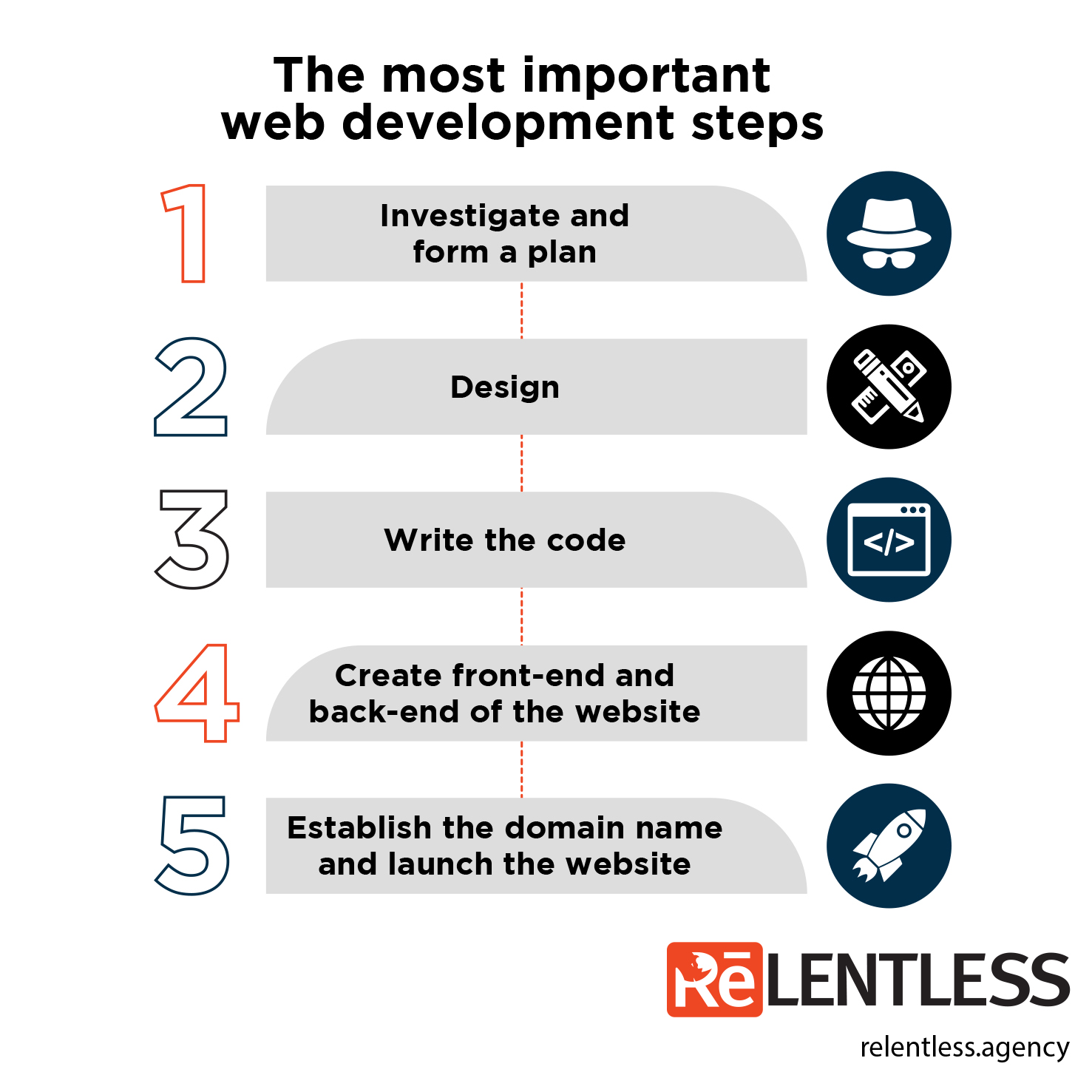Modern technological development has led to a sudden shift in the way people want to live their lives. They want all possible information and want it now without too much effort. So it is easy to forget how complex and demanding web development can be.

What is Web Development?
Web development stands for the process of developing a website. In other words, it is a process of building and maintaining websites and other, more complex digital creations that are accessed and distributed to the public via the Internet or Intranet.
This process consists of several steps, so the term web development includes web design, publishing, programming, and maintenance of websites, no matter how complex their overall structure is. That is the great charm of web development—You can use it to create the most straightforward static pages with plain text, complex web applications, or entire social networks used by millions of users.

Among the web experts, web development usually does not include web design. Instead, their usage of the term usually refers to the process of writing markups, coding, scripting, engineering, and maintenance of server network configuration.
Since the digital market and virtual space are almost infinite, there are many different approaches to web development. That means one person can conduct that entire process or a hundred-developer team. It also means that there are a few types of web development, and which one you choose depends on the current website demands.
Types of Web Development
If you are dealing with the server-side of a website, which is a part of a website that does not interact with users, but its primary function is data storage and data arrangement, you will use back-end web development.
On the other hand, if you wish to work on the parts of the website with which users interact, you will use front-end web development. By using it, you will get an opportunity to adapt the layout and overall interaction between the website and the user: making all functions and options clear and concise, removing unnecessary data, keeping things simple and to the point, not distracting the user with confusing processes of finding information on your website.
Full-stack web development also refers to both processes combined into one greater and more complex development process. In other words, it stands for the development of server-end and client-based software. It has many benefits, such as fast delivery, high efficiency, cost reduction, etc., and demands profound knowledge and experience.
History of Web Development
In its beginnings, the Internet was not closely similar to what we see today. You could only see content as you can read a typed piece of paper; no graphics on a monochrome CRT monitor. Before that, on teletype paper. The only real difference between the two is the amount of noise and paper waste of the latter, but with the same functional results. In the ‘90s, when HTML first became a primary building block of the World Wide Web, coding started to look like today.
That is when developers realized the power of HTML – by using it, you could create different types of digital content and display them to users in captivating ways. Suddenly, one could envision, design, and develop all sorts of websites that would provide a resource of information for users across the globe.
HTML allowed developers to gain new control over the web content. They suddenly became able to implement more profound designs since they had all of the control over the webpage layout.
All digital products are made with a singular purpose – to help somehow users looking for a piece of information, product, or service. That is why developers started paying more attention to users’ needs and demands and started shaping digital content, so it appeals to the majority of people that visit it.
Different developing tools, besides HTML, help web development bloom and reach its golden era. With the development of mobile technology, the demand for mobile applications grew drastically, which only favored web development since it gave developers more space for creative expression.
What is a Must-Know For Every Web Developer?
Since web development is a complex process, one cannot approach it quickly without previous knowledge. Therefore, as a web developer, you should get familiar with and try to understand HTML first, then CSS and JavaScript—for a start. By knowing these scripting languages, you will be able to find your way in the development process. Not being familiar with these languages is like demanding your dog speak the human language – it will never work. However, they are a starting point for web development and the primary tool for interaction between humans and machines.
While JavaScript includes prevalent “frameworks” like Angular.js, Vue.js, W3.JS, React.js, jQuery, etc. XML is connected to XSLT, XPath, XQuery. While you might not need to be an expert in all of these, you must develop your skills in as many possible because it can only benefit you and your practice.
Among all of these tools, you should learn how to run tasks, choose a framework, module loader/bundlers and get comfortable with using different methodologies like SMACSS, Systematic CSS, BEM, etc.
In the end, complete the knowledge by getting familiar with back-end roadmaps. Learn PHP, Python, Node.js, SQL (it’s a must!), and the processes of debugging, profiling, and coaching.
How Complicated is Web Development?
Let’s try to make the whole process of web development a bit more straightforward since there are a lot of different tools you should be familiar with and comfortable using. This is a comprehensive guide but a list of things you’ll need to do, more like a very long reference book table of contents. Each on its own, its universe, and many people devote their professional lives to just one of them, and some make quite a nice living!

Investigate and form a plan
For a start, gather as much information about the website as possible. Check the competition, investigate current trends and their direction, and collect data about user experience, preferences and demands so that you can meet them in the process.
Design
When you gather all the necessary information, proceed to the planning of the website. Try to visualize what it will look like and what you are aiming at, assess your goals, and move to the design process. Take your time, and keep it simple but captivating. Create a nice wireframe for your future website.
Write the script
Proceed to write a script that will bring your website to life. Implement all things you planned along the way. You’ll use HTML (it gives your content a structure), CSS (makes it look pretty), and add JavaScript for interactive elements if you feel like you need to.
Create front-end and back-end of the website
You only need it if there’s information you need to store from a visitor. In a nutshell, make sure your website has a stable back-end structure. Build solid databases and stable servers. Use front-end development to adapt your website to the users and make it appealing. Sort out web browser compatibility and responsiveness, control navigation, positioning of elements, typography, and fonts.
Establish the domain name and launch the website
This is the final step of web development, which some might say, goes before anything we previously wrote in this article (It depends on who you ask). To establish the domain, you need to buy it. Many platforms allow you to do that, for example, GoDaddy, Hover, and even WordPress or Squarespace, which are website builders that will enable you to purchase a memorable domain name. It might be good to have the domain in your pocket before anything, as domain names are bought by “cybersquatters.” So don’t waste time and buy it now!
In conclusion, web development has become one of the most important jobs a person can do since a large portion of the world we know rests upon web development. Websites, web applications, and electronic devices (phones, cars, even microwaves, ovens, and fridges) depend on the development process to bring them to life. In addition, most devices nowadays can somehow connect to “The Net” to carry notifications between them, like when a car pushes a notification to the owner’s phone when it has finished charging or the time at the parking lot is about to expire.
You can compare developers with Mr. Frankenstein, which uses techniques and methods to bring a website to life. If you wish to get your website to life, you have two options: 1) Learn, which will take several years, or 2) try hiring a team of experts to help you with the process.
